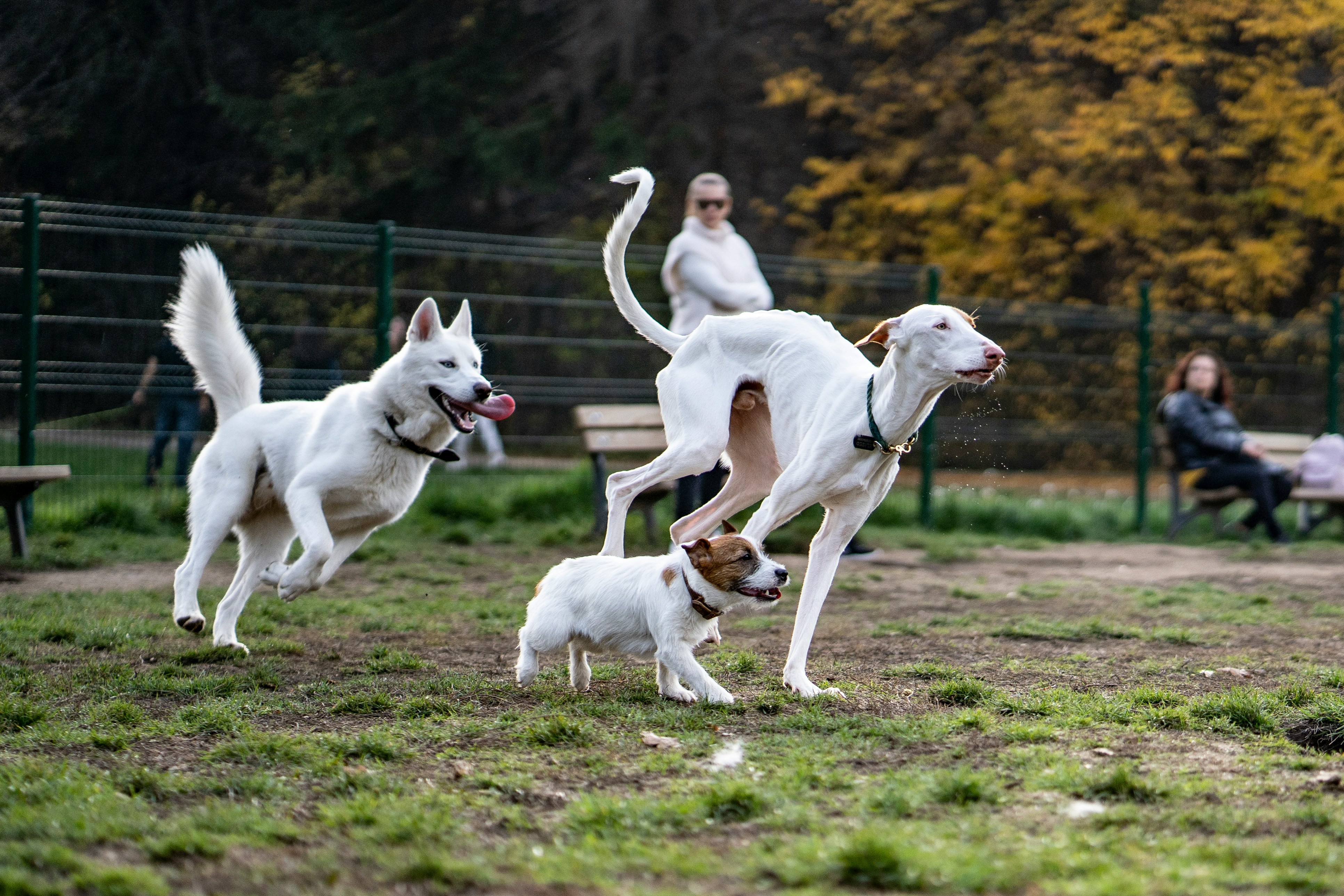More humans should learn to speak “Doggish”

- Dogs are better at understanding humans than we are at understanding dogs.
- Dogs reveal their feelings through sounds, facial expressions, and, most prominently, body postures. By observing dogs, humans can learn to pick up what pups are “saying.”
- Science journalist Jennifer S. Holland recommends dog owners learn to translate “Doggish” and adjust their expectations so dogs can be dogs.
“Come!” “Sit.” “Speak.” “Down.” “Shake.” “Heel!” “Roll over!”
These words are well-known among dog owners. We teach them to our faithful companions so they will learn to understand rudimentary commands and do our bidding. It’s a task dogs are evolutionarily primed for. They keenly observe humans’ hand gestures, body movements, facial expressions, and especially our eyes to try to interpret what we want and how we feel.
The result of this culturally and biologically evolved status quo is that the human-dog relationship is often one-sided. Dogs focus on the wants and whims of humans far more than people consider the emotional needs of dogs. As a result, dogs are better at understanding humans than we are at understanding them.
In her recently published book, Dog Smart: Life-Changing Lessons in Canine Intelligence, science journalist Jennifer S. Holland aimed to help rectify that imbalance. She showcases numerous heartwarming stories of dogs’ devotion to humans and provides fascinating glimpses of — and insights into — their unique intelligence.
A doggy dog world
Pet dog ownership continues to rise in the United States. The American Veterinary Medical Association estimates that 44.6% of households have a dog, up from 38.4% in 2016. These dogs aren’t merely restricted to homes, of course. They share our streets, parks, outdoor festivals, breweries, restaurants, and airports, among many other places. Today, dogs go almost everywhere we do.
This constant contact leads to interspecific misunderstandings that can result in conflict. Altercations are rising in step with pet dog populations. According to the U.S. Centers for Disease Control, over 4.5 million people are bitten by dogs every year in the U.S. These unfortunate incidents send humans to the hospital about 800,000 times per year and contribute to the euthanizing of 390,000 dogs.

Aggressive, poorly-trained pooches are often at fault for bites, but in many cases, humans share the blame. Perhaps an owner brings their dog to a loud, crowded place. Feeling scared and cornered, the anxious animal lashes out at an unsuspecting stranger out of fear for its safety. Maybe an overexcited human hankering for a soft, furry pet rushes a dog and, reaching for its fluffy head, prompts the pup to nip at the outstretched fingers to prevent a perceived attack. These are just two examples where a misunderstanding, not innate aggression, triggers an altercation. To prevent situations like these, and to help humans and canines live more harmoniously together, Holland, along with a great many dog behaviorists, are imploring people to learn to speak basic “Doggish.”
“The better we are at reading … emotions, the more appropriate our responses can be. And that can mean avoiding a bad situation such as a bite, and it can help grow the trust our dogs have in us to be their advocates and protectors,” Holland tells Big Think in an interview.
A crash course in Doggish
Completely mastering Doggish isn’t necessary to mitigate most human-canine misunderstandings. A passing grasp of the canine “language” goes a long way.
“Probably most important is to learn how a dog says, ‘I’m stressed,’ in Doggish,” Holland notes. “You can see stress in their eyes, in their dipped, sometimes-rapidly wagging tails, in their general ‘get small’ body language, but there are other signs.”
While humans and other primates are generally touchy-feely species, dogs are not. A pup approaching to sniff you is rarely an invitation to pet its head or stroke its back. To say ‘hello’ to a cautious but curious pup, it’s best to stand up straight and slightly turn away with your hand down at your side. With this motion, you’re letting them know you’re not a threat or interested in confrontation. Never directly approach an unfamiliar dog and reach down to pet them. In Doggish, you’re essentially issuing a challenge.
Most humans also get petting wrong, massaging our dogs longer and more frequently than they prefer. Pups generally dislike having the top of their head, paws, and hind legs touched, sometimes interpreting pets to these regions as aggressive signals. Instead, research finds that they prefer pets under the chin or slight pats to the sides of the chest.
A major part of learning Doggish is reading a dog’s emotions.
“There are still people who think animals, including dogs, are just instinct machines that don’t experience the full complement of emotions we do,” Holland said. “I don’t agree with that, obviously. While some emotions might manifest differently in dogs than in us, there’s no reason to think they don’t exist. Dogs, and other mammals, have the same brain structures we have [and] that we know are tied to emotions. Scientists can even zoom in and see those emotions lighting up a dog’s brain.”
Dogs reveal their feelings through sounds, smells, and, most prominently, body postures.
“Control by voluntary muscles allows dogs to display a wide range of postures and body part positions that convey different information about the signaler’s inner state and intentions,” a team of animal scientists at the University of Bari in Italy wrote in a widely cited 2018 review on dog communication.

And the tail is a dog’s most visible tool. As the researchers explained:
“The tail is held high to communicate confidence, arousal, or the dog’s willingness to positively approach another individual, for example greeting and playing, while it is held stiff to express a threat or the individual’s anxiety. On the contrary, a tail held low or tucked between the limbs signals fear, anxiety, or appeasement as it contributes to decreasing the individual’s body size. Dogs wag their tails loosely from side to side to communicate friendliness or their excitability. Fast movements of the tail, instead, express different inner states according to its position; dogs communicate confidence if they hold their tail high, while a low wagging is generally associated with anxiousness, nervousness, or internal conflict.”
Meanwhile, dogs broadcast their intentions with their eyes. A hard stare is threatening and says, “Back off!” Avoiding eye contact signals appeasement and a desire to decrease tension. The mouth showcases valuable information, too. A relaxed visage, with the mouth slightly open, displays friendliness while drawing the lips forward to show the front teeth is a warning to steer clear.
Humans can also glean a lot of information from dogs’ ears. According to the researchers:
“Ears can vary from simply ‘back’, to communicate an appeasement intention, to ‘flattened’ or ‘pressed back’, in frightened individuals or as an agonistic response. In extremely fearful individuals, ears can be pressed back so far on the head that they completely disappear (‘seal ears’). On the contrary, ears kept forward are associated with interest, attention, and approach-oriented intentions, while sideward position indicates a conflicting inner state (‘airplane ears’).”
Dogs tend to outwardly display their emotions. They want us and their conspecifics to know what they’re thinking and feeling.
“[Dogs] are not ‘little humans.’ They experience and navigate the world differently from us.”
Jennifer Holland
“It’s important to look at the whole dog, the combination of behaviors and sounds and postures, when assessing what the animal is feeling,” Holland said.
Beyond learning the basics of dog “language,” she recommends that dog owners adjust their expectations of their furry, four-legged companions.
“They are not ‘little humans.’ They experience and navigate the world differently from us,” Holland tells Big Think. “When possible, let them choose — for example, which way to walk and what snack to eat — [or] let them play their way — rough in some cases! Give them a break from manners. A roll in the mud might require a bath later, but your dog will enjoy living in that messy moment so much. And what’s more wonderful than seeing dogs loving life, tongues lolling over big smiles, regardless of what comes next? Their joy is good for us, too.”
Do we really need to learn Doggish?
But is learning Doggish really necessary? Case in point, the internet is frequently amazed by dogs using “talking” buttons to communicate with their owners via audible language. Pups can apparently learn to press buttons with their paws to communicate their feelings and make various requests. Some can seemingly even string together basic sentences!
In reality, these machines, which anyone can purchase, likely rely on operant conditioning. A dog learns that by pressing a certain button, they can get a reward — perhaps a treat, pet, or walk.
But what about instances where dogs use the buttons to form brief sentences?
“They’re likely just responding to their owner’s body language. And they probably wouldn’t be able to replicate the behavior if a new pet-sitter was making the command,” animal behaviorists Susan Hazel and Eduardo Fernandez explain at The Conversation.
So these buttons and other human language-focused methods of communication aren’t perfect.
“There’s nothing wrong with our pets learning our words and using them to get what they need — but I hope we won’t rely on them instead of being close observers who attend to our dogs’ “Doggish” requests effectively,” Holland tells Big Think. “I’m not aware of any great new technology coming down the pike that would replace this kind of natural communication. Of course, there may be technologies akin to MRI that are poised to open new windows onto dogs’ minds; that kind of advance can help us be better conversationalists with our pets, on their terms.”


![a photo of a [dog breed] on a pink background.](https://bigthink.com/wp-content/uploads/2022/04/dog2.jpg)


